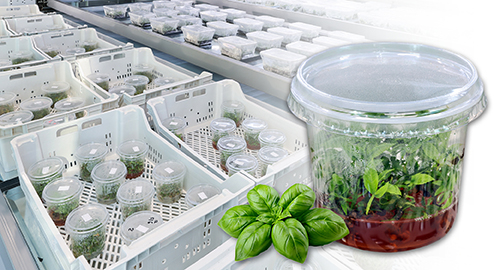The world of logistics, warehouse management, and order fulfillment has undergone numerous changes in recent years, with an ever-increasing demand for efficiency and productivity, to the point that today customers can count on delivery times within two hours from the order. Staying up to date on new procedures and adopting the latest technology becomes essential for companies with the drive to remain competitive and adapt to new market needs.
When it comes to increasing efficiency and productivity in warehouse logistics, automation cannot be ignored. Warehouse robotics is certainly a competitive lever and among the various solutions available Autonomous Mobile Robots (AMR) are proving to be one of the most revolutionary and innovative.
What are Autonomous Mobile Robots (AMR)?
An Autonomous Mobile Robot is any robot capable of moving in its environment without the need for supervision by an operator or the need for fixed and pre-established routes. This means that it is a very sophisticated robot, capable of “awareness” of the surrounding environment thanks to sensors that enable it to:
- Carry out its tasks in the most efficient way and taking the shortest possible route
- Avoid collisions with fixed obstacles (such as fixed structures, shelves, workstations, etc.)
- Avoid collisions with moving obstacles (such as operators, forklifts, etc.).
Other technologies used in warehouse management also perform similar functions (AGVs, for example), but only AMRs offer the kind of flexibility that enable them to always choose the best and safest route when carrying out their tasks. In addition to this, they are able to collaborate with operators during picking and sorting operations.
Integration with warehouse control systems means that Autonomous Mobile Robots can create their own routes and make processes and workflows more efficient and productive, as they perform tasks such as transport, picking, delivery and placement of goods, even in less healthy or hazardous environments, while allowing operators to carry out tasks with greater added value and in safer conditions.
Now let’s see what types of Autonomous Mobile Robots exist and how they can be used in warehouses.
Types of Autonomous Mobile Robots based on their intended use
Since they were first used by NASA for space exploration, AMRs have become a real strategic asset for optimizing the entire supply chain.
For this reason, they are usually distinguished by the tasks performed within the warehouse rather than by model. There are 3 main categories of autonomous automatic robots:
AMRs designed to transport and sort goods within a facility or warehous
Transporting, sorting, and handling goods within a facility are the first operations to be automated where possible. In fact, even if these tasks provide no added value, they require time and staff resources.
Automating the transport of goods frees up personnel who can take on more critical tasks with no need to move from their workstation. There are of course different AMR solutions for handling goods, such as:
- Roller conveyors
- Tiltable trays
- Cross belt sorters.
Each system helps improve warehouse efficiency by handling goods in different weights and shapes, ranging from heavy pallets to small objects.
AMRs designed to support picking processes
Order preparation can be one of the most expensive activities in warehouse management, not so much because it requires qualified personnel but because of the time it takes personnel to move from one place to another to pick goods. AMRs make it possible to significantly reduce travel times from one area of the warehouse to another for picking the various items.
The operating approaches usually applied to picking are:
- Area picking: Each operator in charge of the picking process is assigned an area of the warehouse where the goods are stored. AMRs, which are equipped with an interface showing all the information on the order, move through the various areas of the warehouse with a container where the operators place the items indicated on the interface. Once all the items included in the order have been picked from the various areas of the warehouse, the robot moves to the packaging, consolidation or shipping area. This picking method enables the distribution center to simultaneously manage and complete a large number of orders and is, therefore, an optimal solution for e-commerce.
- Goods-to-person picking: In area picking, in any case, a certain amount of time is wasted, given that the operator has to search for the item stored on the shelves. With G2P logic (that is, goods to person), the aforementioned waste of time is further reduced. In fact, the operator is assigned a picking station to prepare the order, while the AMRs move through the shelves and find exactly the one where the required item is stored. The shelf with the related item is brought to the operator who simply puts it in the order being prepared.
Picking can also be 100% automated by integrating AMRs with tray-based automatic storage systems. Autonomous mobile robots can in fact communicate directly with the storage system and request the needed product along their route. In this way, when the AMR reaches the picking/placing bay the product is ready for picking, while the barcode near the bay is read to confirm the operation.
AMRs for inventory activities
Managing a large distribution center or a warehouse involves another important process that requires significant time and resources: inventory. Knowing the quantities of items stored, placed, picked and processed in real time is critical to minimize errors and bottlenecks or shutdowns.
Also in this case, AMRs are an excellent ally as they can replace the staff who usually carry out time consuming and error-prone activities such as the transport and handling of goods. In fact, when integrated with the warehouse management system, AMRs enable the automation of the inventory process, drastically reducing the time required for this activity and optimizing productivity and accuracy in order fulfillment.
Moreover, inventory activities can be often managed by synergically combining specific automated solutions, for example RFID technology (and RFID gates and portals for goods identification) and AMRs for handling goods (even full pallets or shelves).
The advantages of autonomous mobile robots for distribution centers and warehouses
Within a distribution center or a warehouse, the efficiency of the picking phase (for order preparation) is one of the most important and useful elements for assessing the productivity of the entire logistics process. AMRs can significantly speed up this phase, which means more orders fulfilled per hour with fewer personnel.
An AMR can double the productivity of a picking operator.
We can therefore summarize the advantages provided by the use of Autonomous Mobile Robots in warehouses as follows:
- Reduction in personnel costs
- Increase in the productivity of workers
- More orders fulfilled
- Fewer errors in order preparation and therefore fewer returns
- Increase in worker safety, given that AMRs carry out the most physically demanding tasks and access the most hazardous or unhealthy areas of the warehouse.
7+1 Deadly Sins of the Warehouse



